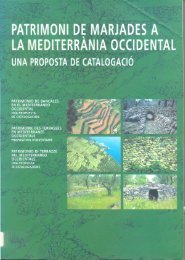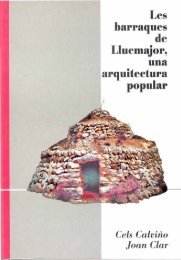La pedra en sec. Materials, eines i tècniques tradicionals a les illes ...
La pedra en sec. Materials, eines i tècniques tradicionals a les illes ...
La pedra en sec. Materials, eines i tècniques tradicionals a les illes ...
Create successful ePaper yourself
Turn your PDF publications into a flip-book with our unique Google optimized e-Paper software.
*** *<br />
** 6 6.2 DRYSTONE MASONRY STRUCTURES<br />
***<br />
LAND ARRANGEMENT rotational axis is inserted in the polleguera<br />
located on the ground.<br />
STRUCTURES. WALLS . Other op<strong>en</strong>ings (clavegueres or<br />
. .: drains) were also built to let water;<br />
Drystone walls are aimed at marklnf! ; herds or hunting animals through, and<br />
the boundaries of holdings, orgam- ; saltadors or botadors (crossing plasing<br />
farmland by delimiting sown ~ ces) were built to allow people to get<br />
fields, cleared land and <strong>en</strong>closed ~ over the walls.<br />
fields, and to keep animals inside ~ The clavegueres were small opeyards,<br />
milking areas or <strong>en</strong>closed ~ nings normally made at ground level.<br />
fields. These walls can be found all ~ Some were built in walls <strong>en</strong>closing<br />
over the isla~d although they are most j grassland to allow sheep or pigs to<br />
widespread In the flatter parts, espe- ; <strong>en</strong>ter and leave, but they can also be<br />
cially in areas with a limestone sub- ; found in <strong>en</strong>closed fields where high<br />
stratum such as the coastal areas of; amounts of rainwater were frequ<strong>en</strong>t;<br />
Llucmajor; the Llevant (the East) and ~ the wall acted as a barrier which stop-<br />
Petra, and in small <strong>en</strong>claves on the ~ ped this water flowing away naturally<br />
Pia (Plain) which have the same type ~ and h<strong>en</strong>ce the risk of the wall collapsof<br />
rock (parts of Llubf, Sineu, Santa j ing was greater.<br />
Eug<strong>en</strong>ia, Algaida and Costltx). ~ The most common saltadors are<br />
There is a great diversity of rock ; raised steps that consist of a series of<br />
types and degrees of dressing to be : stones laid with one <strong>en</strong>d embedded in<br />
found in the island's drystone walls. ~ the wall and the other <strong>en</strong>d projecting<br />
Differ<strong>en</strong>tiation by type is based on ; out. They were placed on both sides<br />
how they are finished, with the excep- ~ of the wall to allow people both to<br />
tions of the paret toma (provisional ~ climb up and to climb down. Oft<strong>en</strong> the<br />
stone wall), made by just piling up sto- ~ crown of the wall was lowered at this<br />
nes, the paret de lIoses (s~one slab f point to make crossing easier; espewall),<br />
which simply CO~SIStS.of a ; cially in the case of walls.<br />
series of flat stone slabs laid vertically,; In exceptional cases some walls<br />
the paret amb bardissa (a wall on ; that are suffici<strong>en</strong>tly wide can be used<br />
which thorny foliage and branches j as paths or as ways of getting betare<br />
placed), and the paret rasan~ (low ~ we<strong>en</strong> terraced fields.<br />
wall), a wall <strong>les</strong>s than a metre high. A ~<br />
distinction is also made by the way of ~<br />
finishing them betwe<strong>en</strong> the esqu<strong>en</strong>a f<br />
d'ase (humpbacked) wall, the paret ;<br />
cabrera (goatherd wall) and the paret :<br />
amb corona (crowned wall). j<br />
The gateway built into the wall (the ~<br />
portell) varies in width dep<strong>en</strong>ding on j<br />
whether it was int<strong>en</strong>ded for use by ~<br />
carts or by animals. Its characteristic :<br />
features are the escassera and the ~<br />
polleguera, two embedded pieces of ~<br />
stone, wood or iron each with a hole ~<br />
in it to hold the vertical bar or polle- ~<br />
guera of the gate. The neck of the pol- ;<br />
leguera turns around the escassera, ~<br />
while the pin or agla that makes the j




